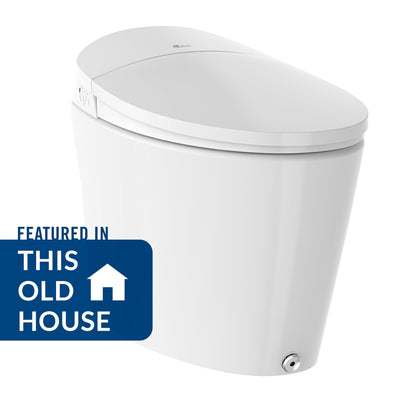The History of the Bidet

The bidet origin story goes back further than you might guess. While modern bidet seats and attachments are only a few decades old, bidets have been around for centuries.
When Was the Bidet Invented?
We don’t know who invented the bidet, but we do know where the bidet originated. Ever wonder why there are so many bidets in France? It’s because the bidet was born there in the 17th century! The first bidets were small fixtures shaped like a bathtub and filled with water.
The term bidet was inspired as a nod to the inevitable position a user took to straddle the bidet basin. “Bidet” means “pony” in French, and the nickname for the device stuck. Bidets became popular in France and spread across much of Europe throughout the 1600s. They were primarily owned and used by middle- to upper-class households, including French nobility.
Bidets in South America, Asia, and Beyond
Bidets hopped the pond to European colonies in South America as early as the 1700s. Bidets also made it to Japan and much of Asia over the course of the 18th century. Bidet use around the world also spread between classes, becoming a fixture in the homes of families across the socioeconomic spectrum.
The History of the Bidet in the US
The one place the bidet toilet couldn’t take root was North America. The US and Canada remained resistant to the idea of bidets well into the 20th century. As The Atlantic magazine points out, American impressions were largely shaped by a false perception. American soldiers serving in France during World War II saw bidets installed in brothels and associated them with sex work. Of course, they would have also found them in many French “water closets” if they’d had the time to look around.
That perception put the adoption of bidets to a halt in the US, but technology and time have started to erode American reluctance toward bidets.
Bidet Designs: Clean, Evolved
The bidet wasn’t static over the centuries. By the 1700s, mechanical pump handles helped generate the first bidet sprayers from a small nozzle in the basin.
Bidet Toilet Seat History: Indoor Plumbing Changes Everything
The advent of indoor plumbing made it easier to supply clean water for bidet use, and the added water pressure made cleaning hands-free. With indoor plumbing, the need for a separate basin for a bidet, and the extra space it required in the bathroom, made less sense. By the 1980s, Japanese bidet toilets combined new technology to create the lavatory equivalent of rocket ships – with toilet seat heaters, automatic open and close functionality, and other comforts we use today.
Bidet toilets and attachments quickly grew in popularity after those upgrades. Today, roughly 80% of all toilets in Japan have a bidet function.
The Evolution of Toilet Seat Bidets
Today, many bidet users utilize a toilet seat bidet or toilet seat attachment. These allow homeowners to quickly retrofit their existing toilet with a device that uses a nozzle to generate a spray of cleansing water, reducing or eliminating the need for wasteful toilet paper. Both options are easy to install without the help of a plumber, making them more accessible for more users, less expensive than a bidet toilet, and adding almost nothing to the space your toilet occupies in your bathroom.
Driving the Future of Bidets
Bio Bidet is known for making high-quality products with innovative features and excellent customer service. We believe strongly that perception of bidet devices is changing in the US and grow around the world, too. Join the revolution, only hundreds of years in the making; use our bidet quiz to find the right bidet style for you!
Questions? Get in touch or check out our model comparison and installation resources.




